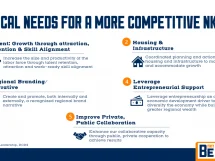FRANKFORT, Ky. — Kentucky Chamber Center for Policy and Research Executive Director Charles Aull testified in front of the Benefits Cliff Task Force, to share employer challenges and policy solutions to address benefits cliffs in Kentucky.
Aull said the ways benefits cliffs create challenges for employers include increasing compensation to attract and retain employees and offering more hours or offering an opportunity to transition from part-time to full-time.
While sharing statistics and trends on employment, wages, and hours, Aull said the benefits cliff issue has become increasingly prevalent in Kentucky’s historically tight labor market.
Aull commended the 2022 General Assembly’s passage of House Bill 708, calling it a step forward for Kentucky. The legislation will require the Kentucky Cabinet for Health and Family Services to create a proposal for a benefit cliff calculator, and bring it to the legislature. Aull stressed the importance of the benefits cliff calculator working for both individuals as well as employers.
Solutions to help address Kentucky’s benefits cliff issue includes leveraging public-private partnerships and the earned income tax credit.
Aull pointed to House Bill 499, the Employee Child Care Assistance Partnership, as an example of a public-private partnership that can help employers be part of the solution. This program encourages non-profit and for-profit employers to offer child care assistance as a benefit of employment by matching employer contributions with state dollars. To help employers prepare for this program, the Chamber released a resource guide.
Increasing utilization of the Earned Income Tax Credit (EITC) should be a priority when looking to address benefit cliffs, Aull said. The EITC is designed to encourage and reward work with the goal of increasing employment, especially for workers with children. Currently in Kentucky, the EITC is used at a rate of 79.9 percent. If the EITC were utilized at 100 percent, 95,000 more Kentuckians would be affected. Kentucky could increase utilization by engaging the Cabinet for Health and Family Services and the Department of Revenue to improve awareness.
One of the most critical workforce issues for Kentuckians is child care, which presents challenges including availability, unexpected closures or changes in hours, non-traditional work schedules, child care deserts, costs, and competition with other benefits.
Aull shared ways employers are addressing workforce issues in their own workplaces, including on-site child care availability, partnerships with local centers, partnerships with CCR&Rs, multi-employer child care services, House Bill 499, flexible scheduling, and remote work.
To address child care issues that are contributing to Kentucky’s benefits cliffs, Aull shared policy considerations from the business community, which include ensuring the success of House Bill 499, stabilizing the Child Care Assistance Program (CCAP), studying local zoning ordinances, ensuring the success of the Business Partnerships Grants Program, leveraging the Employer-Provided Child Care Tax Credit, and the funding the Early Childhood Development Scholarship.



















